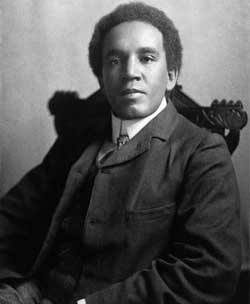Samuel Coleridge-Taylor Biography - A Very Quick Guide
Artist:
Samuel Coleridge-Taylor
Born:
1875
Died:
1912
Who Was Samuel Coleridge-Taylor?
Samuel Coleridge-Taylor (1875–1912) was a British composer and conductor. Sometimes nicknamed “the African Mahler,” he was a mixed-race composer born in London to an English mother and a Sierra Leonean father. His work bridged cultural worlds at a time when opportunities for Black composers were rare.
What Is Hiawatha’s Wedding Feast?
Coleridge-Taylor’s most famous composition, Hiawatha’s Wedding Feast (1898), was a setting of Henry Wadsworth Longfellow’s poem The Song of Hiawatha. The piece became a sensation and was performed hundreds of times in his lifetime. It secured his reputation as one of Britain’s leading composers.
How Did Samuel Coleridge-Taylor Die?
Coleridge-Taylor died from pneumonia at the age of just 37 years old. Despite his popularity, he died in relative poverty. The British government later granted his widow a pension in recognition of his artistic contributions.
When Was Samuel Coleridge-Taylor Born?
He was born on August 15, 1875, in Holborn, London. He studied at the Royal College of Music under Charles Villiers Stanford.
Who Was Avril Coleridge-Taylor?
Avril Coleridge-Taylor (1903–1998) was Samuel’s daughter. She followed in his footsteps as a composer and conductor. Avril often performed her father’s works and promoted greater recognition of Black musicians in Britain.
9 Facts About Samuel Coleridge-Taylor
He was named after the poet Samuel Taylor Coleridge.
His father was a doctor from Sierra Leone.
He studied violin before turning to composition.
Hiawatha’s Wedding Feast was an overnight success.
He toured America three times and met President Theodore Roosevelt.
African-American musicians admired him as a symbol of pride and inspiration.
He founded the Coleridge-Taylor Choral Society in the U.S.
His works blend late-Romantic harmony with African rhythmic vitality.
He wrote chamber music, orchestral suites, and songs in addition to large choral works.
His legacy influenced later Black composers such as Florence Price and William Grant Still.
Samuel Coleridge-Taylor (1875–1912) was a British composer and conductor. Sometimes nicknamed “the African Mahler,” he was a mixed-race composer born in London to an English mother and a Sierra Leonean father. His work bridged cultural worlds at a time when opportunities for Black composers were rare.
What Is Hiawatha’s Wedding Feast?
Coleridge-Taylor’s most famous composition, Hiawatha’s Wedding Feast (1898), was a setting of Henry Wadsworth Longfellow’s poem The Song of Hiawatha. The piece became a sensation and was performed hundreds of times in his lifetime. It secured his reputation as one of Britain’s leading composers.
How Did Samuel Coleridge-Taylor Die?
Coleridge-Taylor died from pneumonia at the age of just 37 years old. Despite his popularity, he died in relative poverty. The British government later granted his widow a pension in recognition of his artistic contributions.
When Was Samuel Coleridge-Taylor Born?
He was born on August 15, 1875, in Holborn, London. He studied at the Royal College of Music under Charles Villiers Stanford.
Who Was Avril Coleridge-Taylor?
Avril Coleridge-Taylor (1903–1998) was Samuel’s daughter. She followed in his footsteps as a composer and conductor. Avril often performed her father’s works and promoted greater recognition of Black musicians in Britain.
9 Facts About Samuel Coleridge-Taylor
African-American musicians admired him as a symbol of pride and inspiration.
Top Pieces on 8notes by Samuel Coleridge-Taylor
